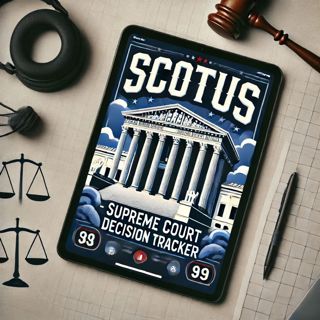
Supreme Court Shakes Up Federal Landscape: Empowering Trump and Reshaping Rights
Listeners, over the past several days, the U.S. Supreme Court has been at the center of sweeping changes and headline-making decisions. Most notably, the justices recently allowed President Donald Trump to move forward with a major executive order, which involves restructuring federal agencies and could lead to mass layoffs of federal workers. This action reflects a trend in which the Court has frequently sided with the Trump administration, often using its so-called “shadow docket”—a fast-track process for making rulings without full briefings or oral arguments. Through this emergency docket, Trump has also been permitted to proceed with controversial plans on mass deportations and to ban transgender people from serving in the military, giving his administration the green light to implement contentious policies, at least temporarily.Ending its term just days ago, the Supreme Court issued major decisions that are reshaping American governance and individual rights. One of the most consequential rulings upheld a state law banning gender-affirming care for minors, marking a significant moment in the national debate over transgender rights and state authority. Civil rights and remedies for challenging federal policies have also been central themes, with the justices narrowing the ability of lower courts to block nationwide policies, further strengthening executive power.On the topic of religious liberty, the Court handed parents a victory, ruling that they can opt their children out of public-school instruction on LGBTQ+ themes if it conflicts with their religious beliefs. In another closely watched case, the justices deadlocked on whether a Catholic charter school could receive public funding, leaving the lower court’s ruling in place and signaling that the issue may return to the docket soon. Elsewhere, the Court declined to take up a case seeking to protect a sacred Native American site from mining, although advocates hope a new petition, in light of recent rulings, might prompt reconsideration.Meanwhile, the Trump administration’s efforts to restrict birthright citizenship were dealt a blow when a federal judge blocked the enforcement of the executive order just days after the Supreme Court’s ruling limited the power of judges to issue nationwide injunctions. The intersection between Supreme Court decisions and lower court actions is generating a dynamic legal landscape, with several major issues likely to return to the high court in the near future.Listeners should also be aware that these Supreme Court actions are already having significant ripple effects across the federal government, particularly as agencies prepare for restructuring, employee layoffs, and the resumption of stalled policy initiatives following these legal green lights.Thanks for tuning in and don’t forget to subscribe for the latest updates. This has been a Quiet Please production, for more check out quietplease dot ai.For more http://www.quietplease.aiGet the best deals https://amzn.to/3ODvOtaThis content was created in partnership and with the help of Artificial Intelligence AI
14 Juli 2min

Supreme Court Decisions Reshape Federal Power and Immigration Debate
The past several days have seen a flurry of significant developments at the U.S. Supreme Court. In a rare move for July, the justices delivered a series of headline-grabbing decisions that have shaped the national conversation. On July 9, the Court lifted a lower court order blocking federal layoffs at nearly two dozen agencies, which effectively allowed the Trump administration to move forward with a large reduction of the federal workforce. This ruling, issued on an 8-1 vote, underscored the president’s broad authority to reorganize executive branch agencies, though more legal challenges are expected as these layoffs begin to roll out, with the State Department already announcing over a thousand job cuts according to OSV News and GoLocalProv.That same day, the Supreme Court refused a request from Florida to revive its hardline immigration law, which made it a state crime to enter Florida illegally or to re-enter the state after deportation. The Court’s decision to allow a lower court’s block to remain in place represents a setback for Florida but signals the continuing legal debate over the extent of state versus federal power in managing immigration enforcement.The justices also recently addressed the Trump administration’s controversial efforts to end birthright citizenship for children born in the U.S. to undocumented parents. A federal district court issued a nationwide injunction to prevent the end of birthright citizenship, and the Supreme Court’s recent decisions indicate this issue will likely be back before them soon as legal battles intensify. Writing for the majority in Trump v. Casa, Inc., Justice Amy Coney Barrett made clear that federal courts have limited power to oversee executive actions beyond the authority granted by Congress, a stance that has sparked substantial public and academic debate.Religious liberty was another major theme as the Court concluded its 2024-2025 term. It handed down multiple unanimous decisions reinforcing protections for religious entities, including a high-profile case involving the Catholic Charities Bureau and a state labor commission in Wisconsin. The Court found in favor of the religious organization, highlighting its ongoing commitment to ensure that Americans can practice their faith in public life without government interference. This trend is expected to continue into the new term, with more religious liberty cases already on the docket.Looking ahead, observers note the Court’s recent rulings have set important precedents on the scope of federal judicial power, particularly around the use of nationwide injunctions. Legal experts point to the Trump v. Casa decision as a turning point, limiting federal judges’ ability to block executive actions nationwide, which has been met with both praise and criticism at legal conferences and in the public sphere.Meanwhile, voting rights advocates are closely watching the Supreme Court as Native American groups in North Dakota signal their intent to petition for review after an appeals court denied their standing in a voting discrimination case. This case could have significant implications for the ability of private parties to sue under the Voting Rights Act going forward.Thank you for tuning in, and don’t forget to subscribe. This has been a Quiet Please production, for more check out quiet please dot ai.For more http://www.quietplease.aiGet the best deals https://amzn.to/3ODvOtaThis content was created in partnership and with the help of Artificial Intelligence AI
13 Juli 3min

"Supreme Court Upholds ACA Provision, Reshapes TCPA Landscape"
Listeners, there have been several significant developments involving the US Supreme Court over the past few days that you should know about. One of the most consequential headlines is the Court’s decision to uphold a key provision of the Affordable Care Act. In Braidwood Management Inc. v. Becerra, the justices voted 6-3 to maintain the ACA’s requirement that most health insurance plans must cover preventive services at no cost to patients. This means that vital services like annual wellness exams, cancer and diabetes screenings, HIV prevention, mental health assessments, and routine vaccinations will continue to be provided without copays or deductibles. This decision has been praised by healthcare leaders for safeguarding patients’ access to essential and potentially lifesaving care while broader challenges to the ACA move forward.Another major Supreme Court action involved the Telephone Consumer Protection Act. On June 20, the Court issued a landmark ruling in McLaughlin Chiropractic Associates v. McKesson Corp., dramatically changing how lower courts handle TCPA claims. The Supreme Court determined that district courts are no longer bound to follow Federal Communications Commission interpretations of the law; instead, they must interpret the TCPA independently. This decision is expected to trigger a wave of new litigation and may prompt businesses to reevaluate their consumer communications practices.Turning to immigration, the Supreme Court delivered a decision in Riley v. Bondi that will create new complexities for noncitizens fighting deportation orders. The Court ruled that the 30-day deadline to seek federal court review of a removal order begins as soon as the Department of Homeland Security issues a reinstatement or administrative removal order, even if the person is still seeking protection from removal in immigration court. Previously, most appeals courts and the Justice Department had agreed that the clock should not start until those protection proceedings end. The justices clarified, however, that missing the 30-day deadline is not an absolute barrier to review, as it is a claims-processing rule rather than a jurisdictional requirement.A related headline involves birthright citizenship. Several federal courts, reacting to a recent Supreme Court ruling, have narrowed the scope of their injunctions against an executive order seeking to end birthright citizenship for children born in the United States to noncitizen parents. The Supreme Court recently limited the ability of lower courts to issue broad, nationwide injunctions, instead pushing for narrower orders that focus on the specific plaintiffs involved. Following this, a New Hampshire federal judge issued an injunction protecting only infants affected by the policy, pending further appeals, while larger constitutional questions remain unsettled.There was also fresh commentary on how the Supreme Court is handling emergency relief requests, often referred to as the “shadow docket.” Just this week, in cases like Trump v. CASA, the Court has continued its trend of granting government requests for stays on lower court rulings without detailed explanation, especially on issues involving the scope of injunctions against federal policies. These orders have drawn criticism from some justices about the standards the Court uses, particularly regarding the government’s claims of irreparable harm.Listeners interested in the ongoing post-9/11 legal proceedings may have heard recent expert analysis on plea deals in the Guantánamo military commission case. While this matter is not before the Supreme Court at present, ongoing litigation and the Court’s evolving standards for emergency relief continue to shape the broader legal landscape, including high-profile terrorism cases.Thanks for tuning in, and don’t forget to subscribe. This has been a Quiet Please production, for more check out quiet please dot ai.For more http://www.quietplease.aiGet the best deals https://amzn.to/3ODvOtaThis content was created in partnership and with the help of Artificial Intelligence AI
11 Juli 4min

Supreme Court Allows Sweeping Federal Workforce Cuts: A Concerning Precedent
In the past three days, the US Supreme Court has made major headlines by allowing the Trump administration to proceed with sweeping cuts to the federal workforce. On Tuesday, the justices issued a 6-3 decision granting an emergency request from the White House, which lifts a lower court’s injunction that had blocked Executive Order No. 14210. This order empowers federal agencies to implement large-scale reductions in force and reorganizations, something officials describe as an effort to streamline government, but which critics—including labor unions and a coalition of local governments and nonprofits—argue bypasses Congress and threatens vital public services.The Court’s majority did not decide on the legality of specific agency cuts, but rather focused on the executive order’s validity and the factors required for an emergency stay. The decision allows the administration’s plans to move forward while legal challenges continue in the lower courts and potentially return to the high court for full review. According to reports from Fox News and GovExec, federal agencies are expected to act quickly and begin mass layoffs now that the injunction has been lifted, as dozens of reduction-in-force actions had been on hold during the legal fight.Justice Ketanji Brown Jackson authored a pointed dissent, arguing that the majority ignored detailed fact-finding by the lower courts and suggesting the Court’s ruling permits an “unprecedented and congressionally unsanctioned dismantling of the federal government.” She warned that the administration’s actions could result in mass terminations, program cancellations, and a significant reduction of federal services before courts have had a chance to rule on the president’s authority.This decision is also notable for its use of the Supreme Court’s so-called “shadow docket,” meaning it was made through an emergency order rather than after full briefing and oral argument. According to the Democracy Forward Foundation, the Trump administration has increasingly relied on this expedited process to push through executive actions while bypassing the traditional, more deliberative judicial review. Critics argue this practice diminishes transparency and long-term accountability.Listeners, thanks for tuning in. Don’t forget to subscribe for the latest updates. This has been a quiet please production, for more check out quiet please dot ai.For more http://www.quietplease.aiGet the best deals https://amzn.to/3ODvOtaThis content was created in partnership and with the help of Artificial Intelligence AI
9 Juli 2min

Supreme Court Rulings Reshape Federal Injunctions and Online Age Verification
Listeners, the latest from the US Supreme Court features a string of high-impact rulings and notable activity just as the Court enters its summer recess.The most prominent headline centers on a Supreme Court decision that sharply limits the power of federal district judges to issue nationwide injunctions. This landmark ruling came in the case Trump v. CASA, Inc., and it directly impacts how lower courts can block federal policies, especially on contentious issues like immigration. In this case, multiple lawsuits challenged a recent executive order from President Trump seeking to restrict birthright citizenship for children born in the US to undocumented immigrants or those with temporary visas. The Court did not rule on the constitutionality of the executive order itself, but concluded that lower courts overstepped by halting the policy nationwide. Instead, the justices insisted injunctions should generally be limited to the specific plaintiffs before the court. This decision is expected to reshape the landscape for lawsuits against federal policies, restricting the use of universal injunctions and affecting ongoing litigation around major federal actions.Another major development is the Supreme Court’s decision to uphold Texas’s age verification law for adult websites in Free Speech Coalition, Inc. v. Paxton. This law requires commercial websites with substantial sexually explicit content to verify users’ ages before granting access, aiming to protect minors from harmful material. The Court applied intermediate scrutiny and found the statute permissible, saying the incidental burden on adults’ access did not violate the First Amendment. Justice Elena Kagan’s dissent, joined by Justices Sotomayor and Jackson, criticized the majority for not applying stricter scrutiny and warned that such laws risk chilling protected adult speech. This ruling could pave the way for similar regulations in other states, with nearly half the country having considered or enacted comparable online age verification laws.Elsewhere, the justices’ activity has shifted from hearing cases to public appearances and academic events. According to Fix the Court, Justice Ketanji Brown Jackson is slated for several upcoming speaking engagements, including an event with the Indianapolis Bar Association and appearances at legal and literary festivals. Justice Kavanaugh will participate in the Eighth Circuit Judicial Conference later this summer, and retired Justice Stephen Breyer is scheduled for a public conversation at Edith Wharton’s former home in Massachusetts.As for pending business, the Court recently remanded several cases from the appeals courts for reconsideration in light of its latest precedents, signaling ongoing refinement of federal judicial authority and standards. Meanwhile, legal circles are watching closely for upcoming cert grants on hot-button topics such as the rights of transgender athletes and campaign finance, which could further shape national policy in the coming term.Thank you for tuning in. Don’t forget to subscribe. This has been a Quiet Please production, for more check out quietplease dot ai.For more http://www.quietplease.aiGet the best deals https://amzn.to/3ODvOtaThis content was created in partnership and with the help of Artificial Intelligence AI
8 Juli 3min

Supreme Court Rulings: Pivotal Decisions and Anticipations Shaping the Legal Landscape
Listeners, here’s the latest with the US Supreme Court. In the final days of its current term, the Court handed down several significant decisions that are making headlines.On June 30, the Court issued a per curiam opinion in Goldey v. Fields. While the particulars of this case haven’t been widely publicized, it’s notable as one of the last decisions of the term. Just prior to that, on June 27, the Court delivered a key ruling in Trump v. CASA, Inc. This case centered on challenges to President Trump’s Executive Order No. 14160 regarding citizenship. The Supreme Court granted a partial stay of lower court injunctions, meaning parts of the executive order can be enforced while appeals continue. This order has been contentious, as it outlines specific conditions under which someone born in the United States is recognized as a citizen, igniting debates about birthright citizenship.Another big decision came with Free Speech Coalition, Inc. v. Paxton, which involved a Texas law requiring age verification for users accessing online sexually explicit content. The law’s intent is to prevent minors from viewing such material. The Court was asked to determine whether a less stringent standard or strict scrutiny should apply when judging the law’s constitutionality, a matter that’s crucial for digital free speech and online privacy.The Supreme Court also addressed federal regulatory power in FCC v. Consumers’ Research. This decision scrutinized the Federal Communications Commission’s authority to require telecom companies to contribute to a fund supporting communication services in underserved communities, a policy that affects both industry practices and consumer access across the country.Beyond decisions, there’s anticipation around unresolved cases, such as constitutional challenges to Louisiana’s congressional map and the scope of federal district courts’ authority to issue nationwide injunctions. These unresolved cases are expected to have broad political and legal ramifications once opinions are released.Listeners, thanks for tuning in. Don’t forget to subscribe, tell a friend, and come back next week for more updates on the Supreme Court and major legal news.This content was created in partnership and with the help of Artificial Intelligence AI
7 Juli 2min

Supreme Court Rulings Reshape Presidential Power and Legal Landscape
The US Supreme Court has recently concluded a series of significant rulings that are reshaping the landscape of legal power in the country, with developments continuing to draw national attention. In the closing days of the last session, the Court handed down decisions that further empowered conservative priorities and the Trump administration’s agenda. One of the most consequential rulings was the decision that former presidents have at least presumptive immunity for their official acts, which has had direct implications for Donald Trump’s legal standing and executive actions.Just before entering summer recess, the justices issued another major opinion, sharply limiting the ability of federal district court judges to block laws or policies nationwide. This ruling, which came in response to challenges over President Trump’s executive order regarding birthright citizenship, establishes that in most cases, judges can only grant relief to the actual parties involved in a lawsuit, not to the whole country. The Court’s 6-3 vote reflected a familiar ideological split, with the liberal justices dissenting and expressing concern that the president’s directive is unlawful. However, the justices did not rule on the legality of Trump’s birthright citizenship order itself; the immediate impact is a significant drop in the power of individual judges to halt federal policy through nationwide injunctions.Earlier in the term, the Trump administration saw an unprecedented frequency of emergency requests before the Court, most of which were successful. Legal challenges to President Trump’s other executive actions, including those related to tariffs and emergency powers, may soon be revisited as the administration continues to implement its agenda. Legal observers are watching closely for how these decisions set new precedents for presidential authority.The Court also recently weighed in on other high-profile cases, addressing issues like regulation of telecommunications and online content, with ongoing cases about transgender rights and executive power still pending. Lower courts are already adapting to the Supreme Court’s rulings, with some judges reportedly searching for ways to navigate around the new limitations on nationwide injunctions.Thank you for tuning in to this update. If you found this overview helpful, please subscribe, tell a friend about our coverage, and join us next week for the latest developments from the Court.This content was created in partnership and with the help of Artificial Intelligence AI
4 Juli 2min

"Supreme Court Rulings Reshape Executive Power, Communications Regulations, and Online Speech Laws"
In the last few days, the US Supreme Court has issued several high-profile rulings and taken actions that have generated significant national attention. One of the most notable headlines is the Court’s decision to sharply limit the power of individual federal judges to issue nationwide injunctions against executive actions. In a 6-3 ruling divided along ideological lines, the Court held that judges can generally only grant relief to the parties directly involved in a lawsuit, rather than extending their decisions to halt government policies nationwide unless the case has been certified as a class action. This decision came as the justices considered lawsuits challenging President Donald Trump’s recent executive order aiming to end birthright citizenship for children born in the US to foreign nationals on temporary visas or without legal status. While the Supreme Court did not rule directly on the legality of the order itself, the ruling does curtail how much impact lower courts can have on major federal policy, representing a significant victory for the Trump administration according to Politico.The case, known as Trump v. CASA, Inc., involved several lower courts that had blocked enforcement of President Trump’s executive order nationwide. The Supreme Court’s action partially stayed those injunctions, narrowing the scope of judicial power in such circumstances. The three liberal justices dissented, arguing the president’s directive was clearly unlawful, but the majority’s ruling now makes nationwide injunctions much harder to obtain in future legal battles. Coverage from the Justia U.S. Supreme Court Center details that these developments are likely to shape future clashes between the executive branch and the judiciary, especially on immigration and civil rights.In another significant case from late June, the Court ruled on FCC v. Consumers' Research, which centered on the Federal Communications Commission’s universal-service fund and how telecommunications companies are required to contribute to subsidies for underserved communities. This ruling, too, is poised to have an impact on how government agencies administer large-scale regulatory programs.Separately, the Court addressed a major First Amendment issue in Free Speech Coalition, Inc. v. Paxton, concerning a Texas law that mandates age verification for websites publishing sexually explicit material. The law was designed to protect minors from accessing such content, and the Court’s handling of the case reflects ongoing judicial scrutiny over how states can regulate online speech while balancing constitutional rights.Listeners, thank you for tuning in for this week’s Supreme Court recap. Don’t forget to subscribe, tell a friend, and please come back next week for more.This content was created in partnership and with the help of Artificial Intelligence AI
2 Juli 2min





















